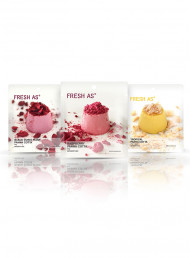Getting the Best from Your Summer Berries

It would be hard to imagine a summer without berries; little jewels of intense colour, ripe flavour and delicate perfume, they shout health and festivity.
Berries' true seasons are spring through to summer, but berries can be found year round now frozen and dried or occasionally freeze-dried. Some respond better than others to different preserving methods. Cranberries, for example, freeze and dry well because they contain high levels of phenolic compounds that help give the fruit its distinctive colour, flavour and perfume.
Their level of acidity and antimicrobial qualities help too. Raspberries and strawberries on the other hand, although high in acidity and phenols are plumped up with water because of their different cell structure, making them far more fragile and susceptible to damage.
Tips: Always choose berries that are plump and richly coloured. Unlike other fruits and vegetables, berries don’t continue to ripen once picked. Avoid any fruit that is crushed, bruised or showing any signs of mould, and always smell them. Distinct fragrance is an excellent sign of freshness.
Any kind of moisture and heat will encourage spoilage so keep your berries in the lower part of the refrigerator uncovered, and rinse them just prior to using them. Strawberries and blueberries in particular retain high levels of chemical sprays so opt for organically grown berries where possible and always wash them carefully before eating them.
To freeze: Wash and dry the berries carefully straight after harvesting. Arrange them in a single layer on a tray lined with baking paper or paper towels to take up any extra moisture. Freeze as quickly as possible until they are solid before transferring them to a freezer bag or box for storage. Most berries will keep for three to six months.
Freeze-dried: most berries can be freeze-dried, a process where the fruit is dehydrated in stages by removing their water content under pressure. It is a complicated process but effective. The fruit can then be stored at room temperature and reconstituted when required. Freeze-dried berries are used in many breakfast cereals or ground to a powder for use in commercial foods like biscuits, cakes, ice creams and confectionery. As with normal freezing, the berries’ vitamins and nutrients are retained along with the colour and aromas.
Dehydrating: Berries also can be dried in a slow oven moderately successfully at home, and also in a domestic dehydrator. Once dried, they do need to be kept airtight to avoid spoilage from mould. Add them to homemade breakfast cereals, muffins and cakes or ice creams and sorbets, bavarois and mousses.
Our Favourite Summer Berry Recipes
Rhubarb and Strawberry Layer Cake
Strawberries and Cream Layered Shake
Chocolate Frangipane Tart with Berries
Lemon Curd, Berry and Pistachio Brioches
Mixed Berry, Rosewater and Crushed Meringue Marshmallow
latest issue:
Issue #114
Autumn has arrived, and with it, the latest issue of dish, jam-packed with recipes that will have you fizzing to get in the kitchen! With a long Easter lunch featuring perfectly pink, blushing roast leg of lamb and wildly decadent baked mashed potatoes with caramelised onions, to simply scrumptious chocolate treats and sensational seasonal baking this issue has you covered - we reckon the Hot Cross Buns are our best yet! Salads make way for soothing soups, pies, puddings and our cover star beef cheek ragù with spaghetti – a must-make dinner for family and friends. With over 60 recipes in our latest issue there’s plenty of inspiration to keep you busy – and well-fed! Don’t forget to share your dish dishes with our Facebook community.

 BROUGHT TO YOU BY New World
BROUGHT TO YOU BY New World


